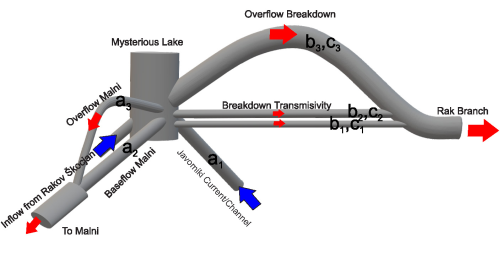Understanding the temporal variation of flow direction in a complex karst system (Planinska Jama, Slovenia)
DOI:
https://doi.org/10.3986/ac.v49i2-3.7373Keywords:
Karst aquifer, groundwater hydraulics, speleohydrology, modelling, Notranjski kras, SloveniaAbstract
Karst aquifers are abundant, but vulnerable water resources. Therefore, a deeper understanding of possible mechanisms that determine the properties of karst springs is crucial. In this work, we present an example of Unica Spring and Malni Spring, the two main outlets of a large karst system in the Notranjska karst region, Slovenia. Although the two springs share same catchment area, the flow distribution between them shows an interesting behaviour: At low-flow conditions, Malni Spring is the main outlet, while Unica spring receives almost no water. During high water events, discharge of Malni Spring stays limited and Unica Spring becomes the main outlet. We relate these observations to the local geometry of the channels and breakdowns in the remote part of the Planinska Jama (Planina Cave), called Mysterious Lake. There, waters from Rakov Škocjan and Javorniki aquifer merge and further diverge to both springs. At low water conditions, the outflow towards the Unica Spring is restricted by the breakdown, so that most of the inflow is directed towards the Malni Spring. With increasing recharge, the level in Mysterious Lake rises until the water starts to flow over the breakdown along a system of large channels (Rak Branch of Planinska Jama) to the Unica Spring. The breakdown level keeps the hydraulic head and the flow towards Malni Spring limited. To verify this scenario, a hydraulic conduit model was made based on the known and predicted channels, and inflows calculated from the historical data of discharge measurements at related springs and ponors. An inversion procedure was used to obtain a satisfactory fit to the observed discharge data and to constrain the selected model parameters. The model accurately reproduced the observed discharge behaviour under low- and
high-flow conditions.
Downloads

Downloads
Published
How to Cite
Issue
Section
License

This work is licensed under a Creative Commons Attribution-NonCommercial-NoDerivatives 4.0 International License.
Authors guarantee that the work is their own original creation and does not infringe any statutory or common-law copyright or any proprietary right of any third party. In case of claims by third parties, authors commit their self to defend the interests of the publisher, and shall cover any potential costs.
More in: Submission chapter




